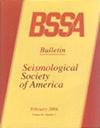2022 年新西兰国家地震灾害模型的地动特征模型
IF 2.9
3区 地球科学
Q2 GEOCHEMISTRY & GEOPHYSICS
引用次数: 0
摘要
本文概述了 2022 年新西兰国家地震危险性模型(2022 NZ NSHM)的地动特征模型(GMC)部分。模型开发过程包括通过创建新的地动数据库来建立新西兰特定的背景,并考虑新西兰历史上使用过的或最近为全球应用开发的替代地动模型(GMMs),无论是否有新西兰特定的区域化。我们明确关注了采用最先进方法的模型,因为这些模型在推断仅受经验数据限制的预测变量情景之外的情况时,能够提供可靠的预测。我们采用了一种 "混合 "逻辑树,它结合了 "模型加权 "方法和骨干模型(即元模型),前者是使用已发布模型为国家高分辨率辐射计应用建立 GMC 逻辑树模型的传统方法,后者则越来越多地用于研究文献和特定地点研究。因此,采用骨干模型结构开发了两个新西兰特有的全球海洋监测模型。逻辑树中所有采用的俯冲地动模型都在其已公布版本的基础上做了进一步修改,以包括弧后地区衰减增加的影响;除一个模型外,所有模型都做了修改,以考虑非线性地表场地响应导致的地动标准偏差减小。除了理论依据之外,这些调整也是使用没有这些影响的模型进行危害敏感性分析的结果,我们认为这些模型给出了不切实际的高危害估计值。本文章由计算机程序翻译,如有差异,请以英文原文为准。
The Ground‐Motion Characterization Model for the 2022 New Zealand National Seismic Hazard Model
This article summarizes the ground‐motion characterization (GMC) model component of the 2022 New Zealand National Seismic Hazard Model (2022 NZ NSHM). The model development process included establishing a NZ‐specific context through the creation of a new ground‐motion database, and consideration of alternative ground‐motion models (GMMs) that have been historically used in NZ or have been recently developed for global application with or without NZ‐specific regionalizations. Explicit attention was given to models employing state‐of‐the‐art approaches in terms of their ability to provide robust predictions when extrapolated beyond the predictor variable scenarios that are well constrained by empirical data alone. We adopted a “hybrid” logic tree that combined both a “weights‐on‐models” approach along with backbone models (i.e., metamodels), the former being the conventional approach to GMC logic tree modeling for NSHM applications using published models, and the latter being increasingly used in research literature and site‐specific studies. In this vein, two NZ‐specific GMMs were developed employing the backbone model construct. All of the adopted subduction GMMs in the logic tree were further modified from their published versions to include the effects of increased attenuation in the back‐arc region; and, all but one model was modified to account for the reduction in ground‐motion standard deviations as a result of nonlinear surficial site response. As well as being based on theoretical arguments, these adjustments were implemented as a result of hazard sensitivity analyses using models without these effects, which we consider gave unrealistically high hazard estimates.
求助全文
通过发布文献求助,成功后即可免费获取论文全文。
去求助
来源期刊

Bulletin of the Seismological Society of America
地学-地球化学与地球物理
CiteScore
5.80
自引率
13.30%
发文量
140
审稿时长
3 months
期刊介绍:
The Bulletin of the Seismological Society of America, commonly referred to as BSSA, (ISSN 0037-1106) is the premier journal of advanced research in earthquake seismology and related disciplines. It first appeared in 1911 and became a bimonthly in 1963. Each issue is composed of scientific papers on the various aspects of seismology, including investigation of specific earthquakes, theoretical and observational studies of seismic waves, inverse methods for determining the structure of the Earth or the dynamics of the earthquake source, seismometry, earthquake hazard and risk estimation, seismotectonics, and earthquake engineering. Special issues focus on important earthquakes or rapidly changing topics in seismology. BSSA is published by the Seismological Society of America.
 求助内容:
求助内容: 应助结果提醒方式:
应助结果提醒方式:


